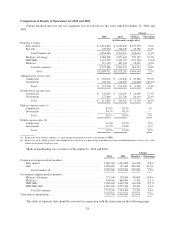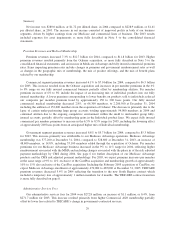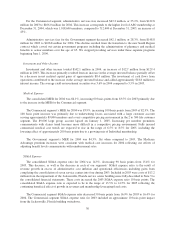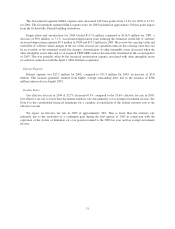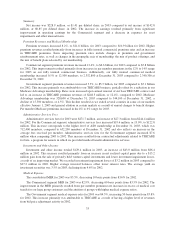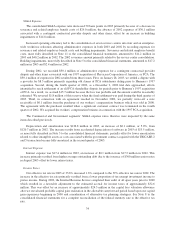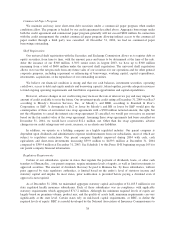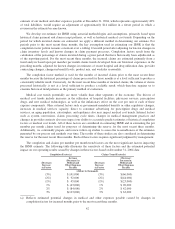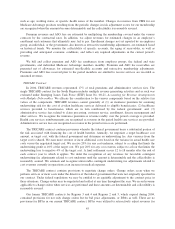Humana 2004 Annual Report Download - page 46
Download and view the complete annual report
Please find page 46 of the 2004 Humana annual report below. You can navigate through the pages in the report by either clicking on the pages listed below, or by using the keyword search tool below to find specific information within the annual report.
TRICARE base receivables increased in 2004 due to the transition to the reimbursement model under the
South Region contract beginning on August 1, 2004. Under our former TRICARE contracts with a fixed price,
we bore the cost of changes in the underlying pattern of health care for which the government was at risk until
subsequently reimbursed in a later period through a bid price adjustment, or BPA process. The fixed price and
BPA process added variability to our revenues, related receivables and operating cash flows because the timing
of the settlement was uncertain. Under the new TRICARE South region contract, the fixed price and BPA
process was eliminated and replaced with a new reimbursement model. Under the new reimbursement model,
claims paid are reimbursed by the federal government generally within 30 business days. The delivery of health
care services results in a lag between the time the service is provided and ultimately reimbursed by the federal
government, typically three months. Thus, TRICARE receivables are generally collected over a three to four
month period. Likewise, TRICARE medical claims payable are generally paid over the same three to four month
period.
TRICARE base receivables increased in 2003 as rates under our base TRICARE contract increased upon the
annual renewal of the contracts for Regions 3 and 4 and Regions 2 and 5.
The detail of medical and other expenses payable was as follows at December 31, 2004, 2003 and 2002:
Change
2004 2003 2002 2004 2003
(in thousands)
IBNR(1) ................................ $1,164,518 $1,043,360 $ 946,596 $121,158 $ 96,764
Reported claims in process(2) ............... 97,801 74,262 105,422 23,539 (31,160)
Other medical expenses payable(3) .......... 159,691 154,534 90,113 5,157 64,421
Total medical and other expenses payable ..... $1,422,010 $1,272,156 $1,142,131 149,854 130,025
Reconciliation to cash flow statement:
Medical and other expenses payable from
acquisition ............................ (71,063) —
Change in medical and other expenses payable
in cash flow statement ................... $ 78,791 $130,025
(1) IBNR represents an estimate of medical expenses payable for claims incurred but not reported (IBNR) at the
balance sheet date. The level of IBNR is primarily impacted by membership levels, medical claim trends
and the receipt cycle time, which represents the length of time between when a claim is initially incurred
and when the claim form is received (i.e. a shorter time span results in a lower IBNR).
(2) Reported claims in process represents the estimated valuation of processed claims that are in the post claim
adjudication process, which consists of administrative functions such as audit and check batching and
handling.
(3) Other medical expenses payable includes capitation and pharmacy payables. The balance due to our
pharmacy benefit administrator fluctuates due to bi-weekly payments and the month-end cutoff.
Medical and other expenses payable increased during 2004 and 2003 due primarily to medical claims
inflation.
Changes in other liabilities primarily resulted from the timing of payments for taxes, payments related to our
TRICARE contract including subcontractors and general vendor payables.
Cash Flow from Investing Activities
During 2004, we paid $141.8 million to acquire Ochsner, net of $15.3 million of cash acquired.
We reinvested a portion of our operating cash flows at an increasing rate over the last several years in
investment securities, primarily short-duration fixed income securities, totaling $407.3 million in 2004, $283.1
million in 2003 and $17.9 million in 2002. Our ongoing capital expenditures primarily relate to our technology
initiatives and administrative facilities necessary for activities such as claims processing, billing and collections,
36




